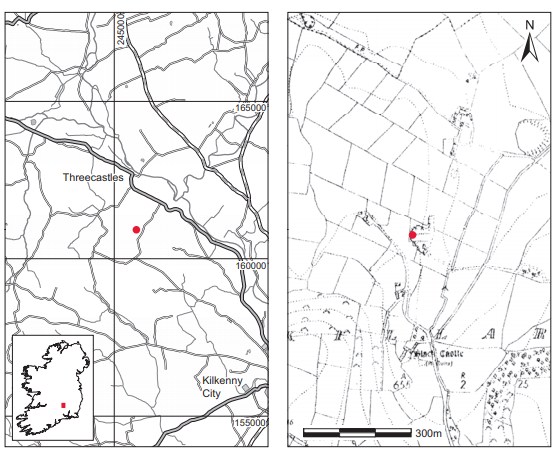County: Kilkenny Site name: KILLAREE, CO. KILKENNY
Sites and Monuments Record No.: SMR KK014-048SMR KK014-047 Licence number: E1101
Author: ELLEN PRENDERGAST
Site type: Iron Age and early medieval graves, c. 300 BCc. AD 1200
Period/Dating: —
ITM: E 645651m, N 660973m
Latitude, Longitude (decimal degrees): 52.697969, -7.324604
Introduction
During quarrying operations in October 1971 workmen discovered a number of extended inhumations along a 20m cutting near Threecastles, Co. Kilkenny. The site was reported to the local Garda Síochána, who informed the NMI. The site was visited by Ellen Prendergast, who collected the visible bone from the surface; she instructed the workers to proceed carefully and to inform the Museum should any objects of interest be discovered. The following day an iron knife was found beside the right femur of a skeleton, at a depth of 0.46m below ground level. The Museum was informed of the find by Mrs Kathleen Lanigan of the Kilkenny Archaeological Society, who had been monitoring works at the site. The site was not revisited by the NMI as the find-spot had been completely destroyed. The human remains from the site were analysed by Professor C.A. Erskine.

Location (Fig. 4.25)
The site was in the townland of Killaree, north Co. Kilkenny.55 It lay above a limestone quarry at an altitude of 90–110m above sea level. The SMR lists a site (KK014-047——) adjacent to this as a potential site located by aerial photography.56
Description of site
The exact number of burials uncovered is unclear as the site was extremely disturbed, but all appear to have been inhumations in unlined graves. They are recorded as being laid out in ‘fairly regular formation’, fully extended, parallel to each other, occasionally overlapping, and aligned west/east. There was no trace of stone protection or grave-cuts, but the skeletons lay in the gravel debris above the limestone quarry. The surface had been very disturbed and the depth of the soil was not uniform throughout the site.57
Bone comprising the remains of six individuals—three female adults, two male adults and one juvenile—was collected from the site (1971:1051).58 No accompanying artefacts were found at the time of Prendergast’s investigation but a tanged iron knife was found next to the femur of an extended inhumation the following day. A fragment of a decorated stone was also found in a disturbed context north of the area investigated by Prendergast. A sample of the human remains was submitted for AMS dating and yielded a date of 1445±40 BP, which calibrates to 550–657.59
Description of objects found during excavation
Tanged iron knife, 1971:1052 (Fig. 4.26)
Iron knife, rusted and flaked; long tang, slightly tapered, rectangular cross-section, with a thick back almost straight. The slope from the back to the tang is long and gradual; the corresponding slope from the cutting edge is short and abrupt. The cutting edge is worn and slightly curved, and there appears to be a short slope from its point to the line of the back of the blade. Found near the femur of an extended skeleton.
Dimensions: overall length 14.2cm; maximum width 2cm; maximum thickness 5mm.
Decorated stone, 1971:1053 (Fig. 4.26)
Stone object fragment used as a whetstone on one face and with traces of incised patterns on the other; probably shale. Two parallel straight edges seem to be original; the irregular narrow ends are broken. The face used as a whetstone has a very smooth polished area diagonally across it. The other face has a more matt surface and in the centre of it an interlace pattern is incised, rather blundered and awkward. Towards the narrow end there may be traces of other patterns. Found in a disturbed context in the vicinity of extended burials.
Dimensions: maximum length 7.7cm; thickness 9mm.
Comment
The artefacts found at the site and the radiocarbon date indicate that it is an early medieval cemetery, and the human remains suggest a mixed population. The discovery of an iron knife is unusual in the context of early medieval burials in Ireland, but occurrences are not unknown. Examples include an inhumation in a long cist at Aghalahard, Cong, Co. Mayo, which was accompanied by an iron knife and a metacarpal of an ox (Raftery and Moore 1944, 171–2). Iron knives have been found in association with inhumations in a number of recent excavations, including a cemetery at Cloghvally, Co. Monaghan (Fintan Walsh, pers. comm.), and one at Raystown, Co. Meath (Stout and Stout 2008, 169).

HUMAN REMAINS
C.A. ERSKINE
The collection (1971:1051) comprises fairly large fragments of the skeletons of at least five adults (three female and two male) and one child of 8–9 years. Each skeleton is represented by relatively few pieces.
Skulls
Mainly bones of vault present and eight pieces of temporal bone. Four fragments of child’s skull. Only a few fragments of three others present. Teeth of two of these show marked wear.
Vertebral column
Fragmentary; parts of all vertebrae present; four first cervical and four second cervical. Altogether eleven fragments of ribs.
Sacrum
One fairly complete male sacrum present. Only fragments of pelvis present, mainly of ilium. One fragment of left ilium of child, and one segment of sarum.
Limbs
Large pieces but radii, ulnae and scapulae poorly represented. No carpal bones present and only one calcaneum. Four metacarpals present. Humeri of the different individuals well represented, including one (possibly two) pieces of child’s humerus. Femora also in large fragments. Tibia and fibula: relatively few large pieces.
55. Parish of Odagh, barony of Crannagh. SMR KK014-048——. IGR 245711 160931.
56. SMR KK014-047——.
57. The maximum depth between the surface and the rock stratum was about 1.5m and the rock had been cleared away to a depth of approximately 0.3m.
58. The location of the skeletons in relation to each other was not noted. See Erskine’s report.
59. GrA-24440.